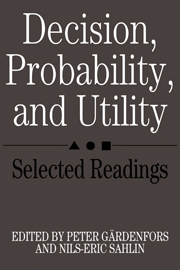Book contents
- Frontmatter
- Contents
- List of contributors
- Preface
- 1 Introduction: Bayesian decision theory – foundations and problems
- Part I Foundations of Bayesian decision theory
- Part II Conceptualization of probability and utility
- Part III Questionable rules of rationality
- Part IV Unreliable probabilities
- Part V Causal decision theory
- References
- Name index
- Subject index
Part II - Conceptualization of probability and utility
Published online by Cambridge University Press: 05 June 2012
- Frontmatter
- Contents
- List of contributors
- Preface
- 1 Introduction: Bayesian decision theory – foundations and problems
- Part I Foundations of Bayesian decision theory
- Part II Conceptualization of probability and utility
- Part III Questionable rules of rationality
- Part IV Unreliable probabilities
- Part V Causal decision theory
- References
- Name index
- Subject index
Summary
This part focuses on some conceptual problems concerning the notions of probability and utility assumed by Bayesian decision theory. One of the founders of the subjective theory of probability, Bruno de Finetti (1979, p. x), proclaimed: Probability does not exist!. He obviously meant that objective probability does not exist. But what about subjective probability and utility? In what way do they exist? How are they conceptualized? The three papers in this part all contain critical examinations of the basic notions and assumptions of the Bayesian program.
To introduce one of the problems, let us assume that you are offered two options and your task is to determine which is the more preferable:
Option 1: In front of you on the table there is an opaque urn containing 30 black and 70 white balls. You are allowed to inspect the balls and the urn. In doing so, you find that the balls are identical except for their color. If, after mixing the balls carefully, you draw a black ball from the urn, you receive $100; if the drawing results in a white ball, you get nothing.
Having read Part I of this book, you argue that your subjective probability that you will draw a black ball is 0.30. If, for simplicity, we assume that, for small sums of money, dollars and utilities are exchangeable, the subjective expected utility of this option is thus $30.
- Type
- Chapter
- Information
- Decision, Probability and UtilitySelected Readings, pp. 97 - 100Publisher: Cambridge University PressPrint publication year: 1988



